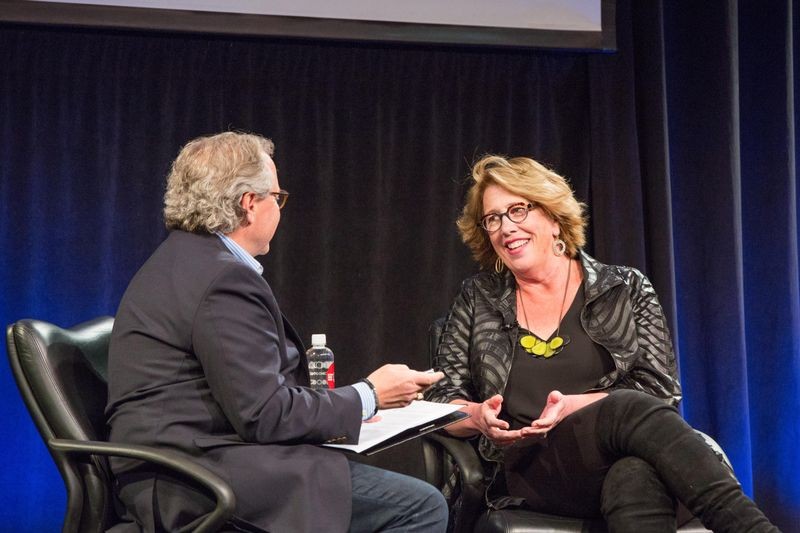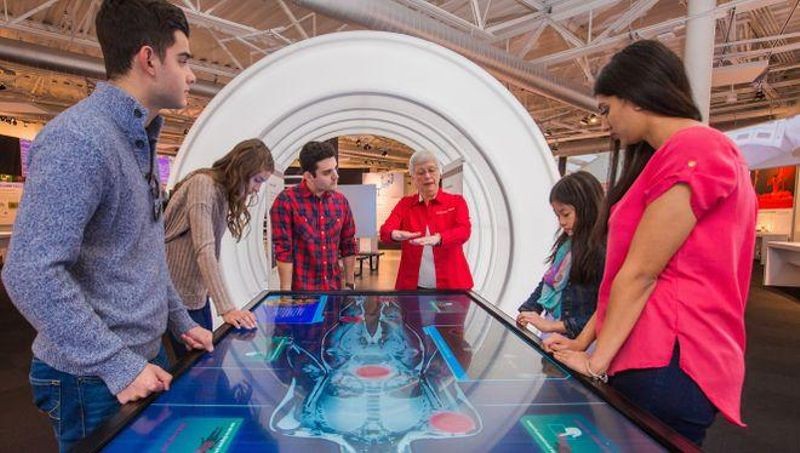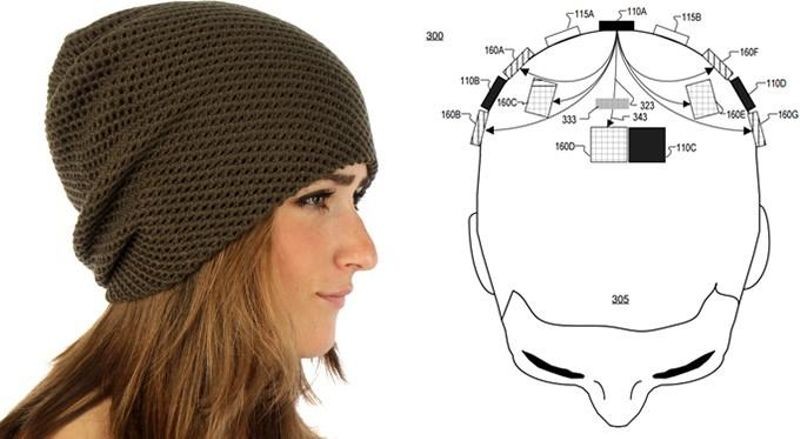

“From Screen Queen to Imaging Innovator: Openwater CEO Mary Lou Jepsen in Conversation with Former Museum CEO John Hollar,” May 4, 2017. Produced by CHM Live at the Computer History Museum.
Before MRI, the inner workings of the human body were a mystery, glimpsed only through dissection or experimentation. Today, this technology doesn’t just allow doctors to better understand anatomy—it is also reducing costs, eliminating unnecessary procedures, and most importantly, saving lives. As we explore in our Make Software: Change the World! exhibition, this fusion of chemistry, physics, engineering, and computing has fundamentally changed the way we diagnose and treat disease.

In our Make Software: Change the World! exhibition, visitors can learn about the history, technology, and impact of MRI through artifacts, video content, and interactive media. Find out more here. Photo: Studio Dizon.
Mary Lou Jepsen has experienced the power of MRI firsthand. After suffering from an unknown disease for years, she was diagnosed with a brain tumor in 1995 following an MRI scan. This experience sparked a longstanding passion for brain science, ultimately leading her to launch her latest venture, Openwater, in 2016. “I was going to die if I didn’t have brain surgery,” Jepsen said at a CHM Live event on May 4. “Neuroscience became a side project as a means of self-preservation.”
Openwater is Jepsen’s vision for a reimagined MRI system. Jepsen is applying her background in engineering, holography, and supply chain management to build a wearable device that can continuously scan your body. This device is the size of a bandage or a beanie, making it incredibly portable, yet capable of providing imaging at a higher resolution than today’s MRI scanners. The implications of a wearable body imaging system are significant for detecting and treating cancer, cardiovascular diseases, and even mental illnesses, especially in remote regions removed from hospitals or in areas without electricity.
[/youtube]
Insert caption here..
Jepsen is enabling this by developing technology that uses the way the body scatters infrared light to develop high-resolution images equal to or better than those produced by an MRI. This is enabled by novel LCDs with pixels small enough to create holographic images, coupled with the use of body-temperature detectors and complex software. These LCDs are small and light enough that they could line a lightweight, wearable device.

This image from Openwater showcases how Jepsen hopes to fit a multi-million dollar MRI system into a ski hat.
By relying on these LCDs that can be made in the same factories that make smart phone screens, Jepsen says her model could cut the cost of medical imaging for patients and doctors by as much as 1,000 times. “The reason healthcare has gotten more expensive is because we have better technology,” said Jepsen. “As technologists working on healthcare, I think it’s part of our job to try to massively lower the cost.”
MRI machines can cost millions of dollars per year to maintain, driving up healthcare costs for patients. How can we make medical imaging more affordable? Openwater CEO & Founder Mary Lou Jepsen describes how she’s designing and manufacturing a wearable imaging device that is cheap to create and reuse...
However, the medical applications of Openwater technology are just the beginning, according to Jepsen. Her end goal is for these devices to enable telepathy via the same imaging technology used in the medical field. “In a decade, when we have this at scale, [...] we can just think something and it can appear. We can skip the whole ‘getting the image out of your head’ [...] I can make my devices work, we leverage the robots, the 3-D printers and all these things that are going to take our jobs,” Jepsen said. “But we’re more creative. We still have a 100 billion neurons each with a 100 thousand different connections. We’re by far the most complex computer ever made.”
Jepsen says that current MRI technology can already reveal the images in your head or the words you’re about to say. Her intention is to build on this technology, allowing devices to read and output our thoughts, in addition to reading the thoughts of others.
Openwater CEO & Founder Mary Lou Jepsen discusses how a brain tumor brought her close to death—and ultimately sparked her interest in neuroscience.e..
Jepsen admits there are cultural and privacy challenges to consider if mind-reading devices become commonly used. “Our system will only work consensually. My fear is that once the technology is out of the bag, people can copy the physics and make one that can work non-consensually,” Jepsen said. “If we’re not controlling that consensual aspect of it, how do we make it so that people can be that switch so it can only work if they wish it to work? That’s the thing that keeps me up at night.” Jepsen says she has already started discussing this with ethicists, advocates and companies from around the world.
Moonshots have been in Jepsen’s mind throughout her prolific career. “As a woman in technology, two things are true: one, I’m underestimated but I’m remembered because I look different. So I learned that if I say crazy stuff, people remember that,” Jepsen said. “When I do the crazy stuff, they’re like ‘Whoa! I thought she was nuts’ [...] and then they bet on you the next time.”
She attributes her ability to think creatively to her ability to combine art, math and science. Before working as an executive at Facebook Oculus and Google [x], Jepsen co-founded One Laptop Per Child with Nicholas Negroponte, where she invented the $100 laptop. She also spent 6 years living in Taiwan, leading the world’s only fabless display screen company, PixelQi. She holds a PhD in Optical Physics (Photonics) and an Sc.B in Electrical Engineering both from Brown University in addition to a degree in Computational Holography from the MIT Media Lab. In addition to helping build the world’s first holographic video system, Jepsen also worked as a multimedia artist, making holograms for her pieces.
Former Google and Facebook Oculus executive Mary Lou Jepsen shares how combining her interests in math, technology, and art has helped make her more creative and why she advocates for STEAM, not just STEM, in education...
“From Screen Queen to Imaging Innovator: Openwater CEO Mary Lou Jepsen in Conversation with Museum CEO John Hollar,” May 4, 2017. Produced by CHM Live...